Fahl LARYVOX® HANDS-FREE VALVE KOMBI HME Mode d'emploi
- Taper
- Mode d'emploi

LARYVOX® HANDS-FREE VALVE
GEBRAUCHSANWEISUNG
INSTRUCTIONS FOR USE

2
DE/
EN BILDER / PICTURES
DE/
EN PIKTOGRAMM-LEGENDE / PICTROGRAM LEGEND
123
456
dBestellnummer /
Catalogue number
nChargenbezeichnung /
Batch code
PGebrauchsanweisung beachten /
Consult instructions for use
IVerwendbar bis /
Use by
GCE-Kennzeichnung /
CE marking
5Einpatientenprodukt /
single patient use
QInhaltsangabe in Stück /
Content (in pieces)
mBei beschädigter Verpackung
nicht zu verwenden /
Do not use if package is damaged
bHersteller /
Manufacturer

3
DE
I. Vorwort
Diese Anleitung gilt für LARYVOX® Hands-Free Valve Sprechventile. Die
Gebrauchsanweisung dient der Information von Arzt, Pegepersonal und
Patient/Anwender zur Sicherung einer fachgerechten Handhabung. Bitte lesen
Sie die Gebrauchshinweise vor erstmaliger Anwendung des Produkts
sorgfältig durch!
II. Bestimmungsgemäßer Gebrauch
Das verstellbare LARYVOX® Hands-Free Valve ermöglicht Patienten mit
teilweise oder vollständig erhaltenem Kehlkopf sowie Stimmprothesen- (Shunt-
Ventil-) Trägern das ngerfreie Sprechen. LARYVOX® Hands-Free Valve
besteht aus einem Kunststogehäuse, einer Silikonmembranscheibe und einem
exiblen Gehäusering, mit dem die Schließempndlichkeit der Silikonmembran
eingestellt werden kann. Das Ventil ist ausschließlich in Kombination mit einer
Phonationskanüle mit 22-mm-Adapter sowie mit LARYVOX® Tape Basisplatten
verwendbar. Die Auswahl, Verwendung und das Einsetzen der Produkte muß
bei Erstgebrauch durch einen geschulten Arzt oder geschultes Fachpersonal
vorgenommen bzw. besprochen werden.
III. Warnungen
• Sprechventile sind Einpatientenprodukte und damit ausschließlich für die
Anwendung bei einem einzelnen Patienten - auch zum Mehrfachgebrauch
- bestimmt.
• Jeglicher Wiedereinsatz bei anderen Patienten und damit auch eine
Aufbereitung zum Wiedereinsatz bei einem anderen Patienten ist unzulässig.
• Reinigen Sie die LARYVOX® Hands-Free Valve Sprechventile nur mit vom
Hersteller zugelassenen Reinigungsmitteln.
• Eine Sterilisation des LARYVOX® Hands-Free Valve ist nicht möglich.
• Das Erhitzen über 65 °C, das Auskochen oder eine Dampfsterilisation sind
nicht zulässig und führen zu einer Beschädigung des Sprechventils.
VI. Komplikationen
• Sollte Ihnen das ngerfreie Sprechen trotz größtmöglicher
Membraneinstellung nicht gelingen oder sollten Sie das ngerfreie Sprechen
als beschwerlich empnden, könnte eine logopädische Unterstützung
notwendig sein. Bitte befragen Sie Ihren Arzt.
• Bei zu hohem Druck, wie z.B. beim Husten, kann die Ventilmembran
(Silikonmembranscheibe) durch die Frontplattenönung (Gehäusering)
gedrückt werden, begleitet von einem Geräusch schnell entweichender Luft.
Ziehen Sie in diesem Fall das ganze Sprechventil von der Kanüle/Basisplatte
ab und bringen Sie die Ventilmembran vorsichtig mit der Fingerspitze in
die ursprüngliche Position zurück. Vor allem zum Abhusten sollte das
Sprechventil immer abgenommen werden, um ein Verkleben der Membran
und damit eine Funktionsbeeinträchtigung zu verhindern.
LARYVOX® HANDS-FREE VALVE

4
DE • Für den stimmlichen Erfolg ist die komplette Abdichtung des Tracheostomas
erforderlich. Dieses kann über eine Trachealkanülenversorgung, über
eine Basisplatte oder über eine Kombination aus beidem (z.B. e.g.
LARYNGOTEC®, LARYNGOTEC® KOMBI CLIP LINGO and LARYVOX®
Tape) erreicht werden.
• Ist der Partikellter verstopft oder zeigen sich Anzeichen einer Verstopfung,
so ist das Laryvox® Hands-Free Valve Sprechventil unverzüglich zu
entfernen und zu reinigen.
V. Vorsicht
Es ist darauf zu achten, dass die Ventilönung nicht durch Kleidung o.Ä.
blockiert wird, um eine ungehinderte Atmung zu ermöglichen (Gefahr der
Atemnot).
VI. Kontraindikation
LARYVOX® Hands-Free Valve darf ausschließlich von Patienten mit teilweise
oder vollständig erhaltenem Kehlkopf sowie Stimmprothesen- (Shunt-Ventil-)
Träger verwendet werden! Das LARYVOX® Hands-Free Valve muss vor dem
Schlafen entfernt werden, um eine potentielle Blockierung der Luftwege zu
vermeiden!
VII. Produktbeschreibung
Das LARYVOX® Hands-Free Valve Sprechventil gibt es in unterschiedlichen
Ausführungen:
LARYVOX® Hands-Free Valve Low Resistance (REF 21984)
• Es ist geringer Anblasdruck nötig, um das Sprechventil zu schließen
• Der über dem Gehäuse verlaufende Bügel dient zur manuellen
Feinabstimmung der Membraneinstellung und als Abstandshalter für
Textilien
LARYVOX® Hands-Free Valve Normal / Low Resistance für
TrachiNaze® (REF 21981/21980)
• Ermöglicht eine Kombination mit TrachiNaze® Plus Filtern
• Die Ausführung NORMAL RESISTANCE besitzt eine blaue Ventilscheibe
- diese ist etwas dicker und schwerer als die farblose Ventilscheibe in der
Ausführung LOW RESISTANCE
• In der Ausführung LOW RESISTANCE ist nur ein geringer Anblasdruck
erforderlich, um das Sprechventil zu verschließen
LARYVOX® Hands-Free Valve Kombi HME Normal / Low Resistance
(REF 21983/21982)
• Der integrierte Kombi-Adapter dient zur Aufnahme von allen Filterkassetten
mit einem 22-mm Anschluss wie z.B. LARYVOX® HME Filterkassetten oder
HUMIDOTWIN®.
• In der Ausführung LOW RESISTANCE ist nur ein geringer Anblasdruck
erforderlich, um das Sprechventil zu verschließen

5
DE
VIII. Anleitung
• Nehmen Sie das Ventil aus der Verpackung, reinigen und trocknen
Sie es vor erstmaliger Anwendung gem. Anleitung (Reinigung und
Desinfektion).
• Vor jedem erneuten Einsetzen des LARYVOX® Hands-Free Valve ist
die Vollständigkeit, Beschädigungsfreiheit und Funktionstüchtigkeit des
Produkts vom Anwender zu überprüfen ➊!
• Um Verletzungen auszuschließen ist es ratsam, das Sprechventil zunächst
mit der Trachealkanüle zu verbinden und anschließend die Trachealkanüle
samt dem Sprechventil in das Tracheostoma einzusetzen. Anderenfalls
könnte beim Einrasten des Sprechventils über das Kanülenrohr ein zu hoher
Druck auf die Schleimhäute der Trachea ausgeübt werden.
• Sie sollten das Sprechventil vor Anbringung justieren und durch Drehen die
Önungsstärke der Ventilscheibe einstellen ➋. Je weiter das Ventil geönet
ist, desto mehr Luft kann eingeatmet werden. Allerdings ist dann auch der
Ausatemdruck, der zum Verschließen des Ventils beim Sprechen erforderlich
ist, größer. Bei normaler Atmung und normaler körperlicher Aktivität empehlt
es sich daher das Ventil so einzustellen, dass ausreichend Luft einströmen
kann, das Ventil aber nicht komplett geönet ist. Eine maximale Önung des
Ventils empehlt sich nur bei anstrengenden körperlichen und sportlichen
Aktivitäten, bei der die Atmung verstärkt ist.
• Nachdem die Ventilscheibe in der gewünschten Önungsstärke justiert
wurde, wird das Sprechventil mit dem Einsatzring, der an dem kleinen
umlaufenden Haltewulst zu erkennen ist, in den 22-mm-Adapter der
Kanüle ➌ eingesetzt.
• Bei der Verwendung von speziellen Basisplatten zum Aufkleben
(z.B. Laryvox® Tape) wird zunächst die Basisplatte gemäß Anleitung
befestigt.
• Anschließend wird vorsichtig das LARYVOX® Hands-Free Valve in den
Haltering der ➍ Basisplatte eingesetzt, so dass eine festsitzende Verbindung
hergestellt wird.
• Bei LARYVOX® Hands-Free Valve für TrachiNaze® und LARYVOX®
Hands-Free Valve Kombi HME nun den zusätzlichen Filter einsetzen ➎/➏.
• Der Haltewulst sorgt für einen stabilen Sitz des Sprechventils.
• Der Bügel (Ausführung LARYVOX® Hands-Free Valve Low Resistance)
dient als Abstandshalter, um zu verhindern, dass die Atmung durch
Kleidung o.Ä. eingeschränkt wird. Er ist nicht als Gri für die Platzierung des
Sprechventils geeignet.
IX. Nutzungsdauer
• Die Haltbarkeitsdauer des LARYVOX® Hands-Free Valve wird durch viele
Faktoren beeinusst. So können die Zusammensetzung des Sekrets, die
Gewissenhaftigkeit der Reinigung und andere Aspekte von entscheidender
Bedeutung sein.
• Das LARYVOX® Hands-Free Valve hat bei guter Pege eine zu erwartende
Haltbarkeit von 12 Monaten. Danach ist das Produkt auszutauschen.

6
DE • Ein Sprechventil, das auch nur eine geringfügige Beschädigung aufweist,
muss sofort ausgetauscht werden.
• Sprechventile, die gegenwärtig nicht in Gebrauch sind, sollten in trockener
Umgebung in einer sauberen Kunststodose und geschützt vor Staub,
Sonneneinstrahlung und/oder Hitze gelagert werden.
X. Reinigung und Desinfektion
1. Reinigung
Um die Funktion des Sprechventils durch anhaftende Sekretreste nicht zu
beeinträchtigen und das Risiko für eine Infektion zu minimieren, ist das
LARYVOX® Hands-Free Valve mindestens zweimal täglich gründlich zu
reinigen, bei starker Sekretbildung entsprechend öfter.
Reinigungsschritte
• Entfernen Sie vorsichtig das Sprechventil, in dem sie dieses aus dem Adapter
der Kanüle bzw. aus dem Haltering der Basisplatte herausdrehen/-ziehen.
• Entfernen Sie dann eventuell verwendete Filtersysteme.
• Für die Sprechventilreinigung kann eine milde, ph-neutrale Waschlotion
verwendet werden. Wir empfehlen, das spezielle Kanülenreinigungspulver
OPTIBRUSH® CLEAN (REF 31110) nach Anleitung des
Herstellers zu verwenden. Zur Erleichterung der Reinigung empfehlen wir
die Verwendung einer Kanülenreinigungsdose OPTIBRUSH® CONT (REF
31200).
• Spülen Sie anschließend das Sprechventil mehrmals gründlich mit
klarem Wasser ab und trocknen Sie es mit einem sauberen, weichen und
fusselfreien Tuch. Benutzen Sie keine scharfkantigen Reinigungsgeräte!
• Alternativ ist auch eine Reinigung durch thermische Desinfektion bei max.
65 °C möglich. Verwenden Sie hierfür sauberes, max. 65 °C warmes
Wasser. Achten Sie darauf, dass die Temperatur konstant gehalten wird
(Temperaturkontrolle durch Thermometer) und vermeiden Sie unter allen
Umständen ein Auskochen durch siedendes Wasser. Dies könnte das
Sprechventil erheblich beschädigen.
2. Anleitung chemische Desinfektion
• Eine Desinfektion sollte immer dann vorgenommen werden, wenn dies vom
behandelnden Arzt aufgrund des spezischen Krankheitsbildes bestimmt
wird oder durch die jeweilige Pegesituation indiziert ist.
• Eine Desinfektion wird in der Regel zur Vermeidung von Kreuzinfektionen
und beim Einsatz in stationären Bereichen (z.B. Klinik, Pegeheim und/
oder andere Einrichtungen im Gesundheitswesen) angebracht sein, um
Infektionsrisiken zu reduzieren.

7
DE
Desinfektionsschritte
• Zur Desinfektion muss das Sprechventil im Anschluss an die oben
beschriebene Reinigung für 10 bis 15 Minuten in eine Desinfektionslösung
eingelegt werden.
• Hierfür darf ausschließlich das OPTICIT® Kanülen-Desinfektionsmittel
(REF 31180; nicht erhältlich in den USA) gemäß Herstelleranleitung
verwendet werden. Alternativ empfehlen wir ein Desinfektionsmittel auf der
Wirkstobasis Glutardialdehyd (unter anderem erhältlich in den USA). Hierbei
sollten immer die jeweiligen Herstellervorgaben zum Anwendungsbereich
und Wirkungsspektrum beachtet werden.
• Nach der Desinfektion ist das LARYVOX® Hands-Free Valve innen wie
außen sehr gründlich mit sterilem oder erkaltetem, abgekochtem Wasser
abzuspülen und anschließend zu trocknen.
XI. Allgemeine Geschäftsbedingungen
Der Hersteller Andreas Fahl Medizintechnik-Vertrieb GmbH übernimmt keine
Haftung für Funktionsausfälle, Verletzungen, Infektionen und/oder anderen
Komplikationen oder andere unerwünschte Vorfälle, die in eigenmächtigen
Produktänderungen oder unsachgemäßen Gebrauch, Pege, und/oder
Handhabung begründet sind. Insbesondere übernimmt die Andreas Fahl
Medizintechnik-Vertrieb GmbH keine Haftung für Schäden, die durch
Änderungen des Sprechventils oder durch Reparaturen entstehen, wenn diese
Änderungen oder Reparaturen nicht vom Hersteller selbst vorgenommen
worden sind. Dies gilt sowohl für hierdurch verursachte Schäden an den
Sprechventilen selbst als auch für sämtliche hierdurch verursachten
Folgeschäden. Bei Anwendung des Sprechventils über den unter Zier IX
genannten Anwendungszeitraum hinaus und/oder bei Gebrauch, Verwendung,
Pege (Reinigung, Desinfektion) oder Aufbewahrung des Sprechventils
entgegen den Vorgaben dieser Gebrauchsanleitung wird die Andreas Fahl
Medizintechnik-Vertrieb GmbH von jeglicher Haftung einschließlich der
Mängelhaftung – soweit gesetzlich zulässig – frei.
Der Verkauf und die Lieferung aller Produkte der Andreas Fahl Medizintechnik-
Vertrieb GmbH erfolgen ausschließlich gemäß den allgemeinen
Geschäftsbedingungen (AGB); diese können Sie direkt bei der Andreas Fahl-
Medizintechnik Vertrieb GmbH erhalten. Produktänderungen seitens des
Herstellers bleiben jederzeit vorbehalten. LARYVOX® ist eine in Deutschland
und den europäischen Mitgliedsstaaten eingetragene Marke der Andreas Fahl
Medizintechnik-Vertrieb GmbH, Köln.

8
EN I. Foreword
These instructions for use are valid for LARYVOX® Hands-Free speaking
valves. The instructions for use serve to inform the physician, nursing sta and
patient/user in order to ensure technically correct handling. Please read the
instructions for use carefully before using the product for the rst time!
II. Intended Use
The adjustable LARYVOX® Hands-Free Valve enables patients with partially
or fully preserved larynx as well as persons wearing voice prostheses (shunt
valve) to speak without having to use their ngers. The LARYVOX® Hands-
Free Valve consists of a plastic housing, a silicone diaphragm disc and a
exible housing ring, with which the closing sensitivity of the silicone diaphragm
can be adjusted. The valve is intended for use exclusively in combination with
a phonation cannula with 22 mm adapter as well as with LARYVOX® Tape
base plates.
When used for the rst time, the products must be selected, employed and
inserted by physicians or medical professionals trained in their use, and the
user must be instructed in this regard by such medical professionals.
III. Warnings
• Speaking valves are single-patient products and are thus intended
exclusively for use by one patient only. They can be used several times by
the same patient.
• Re-use of any kind in other patients and thus also reconditioning for re-use
in other patients is not allowed.
• Clean the LARYVOX® Hands-Free speaking valves only with cleaning
agents approved by the manufacturer.
• The LARYVOX® Hands-Free Valve cannot be sterilised.
• Heating to over 65°C, disinfection with boiling water or steam sterilisation are
not allowed and lead to damage of the speaking valve.
VI. Complications
• If hands-free speaking is not possible for you despite the largest possible
diaphragm setting, or if you nd hands-free speaking dicult logopaedic
training may be necessary. Please consult your physician.
• If the pressure is too high, e.g. if you are coughing, the valve diaphragm
(silicone diaphragm disc) may be forced through the opening in the front
plate (housing ring), accompanied by the sound of rapidly escaping air. If this
happens, pull the entire speaking valve away from the cannula/base plate
and with your ngertips return the valve diaphragm carefully to the original
position. Especially if you need to cough, you should always remove the
speaking valve to prevent the diaphragm from sticking and thus impairing
the function.
LARYVOX® HANDS-FREE VALVE

9
EN
• To ensure vocal success, the tracheostoma must be completely sealed. This
can be achieved by providing a tracheostomy tube, by a base plate or by
a combination of the two (e.g. LARYNGOTEC®, LARYNGOTEC® KOMBI
CLIP LINGO and LARYVOX® Tape).
• If the particle lter is clogged or if signs of clogging appear, the LARYVOX®
Hands-Free speaking valve must immediately be removed and cleaned.
V. Precautions
Care must be taken to ensure that the valve opening is not blocked by clothing
or the like in order to enable unhindered breathing (risk of respiratory distress).
VI. Contraindication
The LARYVOX® Hands-Free Valve is permitted for use exclusively by
patients with partially or fully preserved larynx as well as persons wearing voice
prostheses (shunt valve)!
The LARYVOX® Hands-Free Valve must be removed before going to sleep to
prevent potential obstruction of the airways!
VII. Product description
The LARYVOX® Hands-Free speaking valve is available in a number of
dierent versions:
LARYVOX® Hands-Free Valve Low Resistance (REF 21984)
• Only low blowing pressure is required to close the speaking valve
• The strap running across the housing can be used for manual ne tuning of
the diaphragm setting and as a spacer for textiles
LARYVOX® Hands-Free Valve Normal / Low Resistance for TrachiNaze®
(REF 21981/21980)
• Can be used in combination with TrachiNaze® Plus lters
• The NORMAL RESISTANCE version has a blue valve diaphragm, which is
somewhat thicker and heavier than the uncoloured valve diaphragm in the
LOW RESISTANCE version
• In the LOW RESISTANCE version, only low blowing pressure is required to
close the speaking valve.
LARYVOX® Hands-Free Valve Kombi HME Normal / Low Resistance
(REF 21983/21982)
• The integrated combination adapter is used to accommodate all lter
cassettes with a 22 mm port, such as LARYVOX® HME lter cassettes or
HUMIDOTWIN®, for example.
• In the LOW RESISTANCE version, only low blowing pressure is required to
close the speaking valve.
VIII. Instructions
• Take the valve out of the packaging, clean and dry it before rst use in
accordance with the instructions (Cleaning and Disinfection) prior to rst use.

10
EN
• The user must check the Laryvox® Hands-Free Valve for completeness,
absence of damage and proper functioning of the product each time before
inserting it again ➊!
• To prevent injury, it is advisable to rst connect the speaking valve to the
tracheostomy tube and then to insert the tracheostomy tube with attached
speaking valve into the tracheostoma. Otherwise, excessive pressure could
be exerted on the mucous membranes via the cannula tube when the
speaking valve is snapped into place.
• You should adjust the speaking valve before attaching it and set the opening
thickness of the valve disc by turning it ➋. The further the valve is opened,
the more air can be inhaled. However, the exhalation pressure necessary to
close the valve while speaking is then also greater. For normal respiration and
normal physical activity, it is therefore recommended that you set the valve
such that sucient air can ow in, but without opening the valve completely. It
is recommended that you open the valve to the maximum only for strenuous
physical and sporting activities, in which your breathing becomes deeper.
• After you have adjusted the valve disc to the desired opening thickness,
insert the speaking valve together with the insertion ring, which can be seen
on the small circumferential retaining bead, into the 22 mm adapter of the
cannula ➌.
• If special base plates are used for adhesion (e.g. LARYVOX® Tape), rst
fasten the base plate according to the instructions.
• Then carefully insert the LARYVOX® Hands-Free Valve into the retaining
ring of the ➍ base plate, so that a secure connection is established.
• If you are using a LARYVOX® Hands-Free Valve for TrachiNaze® and
LARYVOX® Hands-Free Valve Combi HME, now insert the additional lter
➎ / ➏.
• The retaining bead ensures that the speaking valve will be seated stably.
• The strap (LARYVOX® Hands-Free Valve Low Resistance version) serves
as a spacer to prevent restriction of breathing by clothing or the like. It is not
suitable as a handle for positioning the speaking valve.
IX. Service Life
• The service life of the LARYVOX® Hands-Free Valve is inuenced by many
factors. Thus, the composition of secretions, conscientious cleaning and
other aspects can be of decisive signicance.
• The LARYVOX® Hands-Free Valve has an expected life of twelve month
when carefully treated. After that, the product must be replaced.
• A speaking valve showing damage of any kind, even if only minor, must be
replaced immediately.
• Speaking valves that are presently not being used should be stored in a dry
environment in a clean plastic container, protected from dust, sunlight and/
or heat.

11
EN
X. Cleaning and Disinfection
1. Cleaning
The LARYVOX® Hands-Free Valve must be cleaned thoroughly at least twice
a day, and in situations with strong secretion production correspondingly more
often, to prevent functional impairment of the speaking valve by adhering
residues of secretions and to minimise the risk of infection.
Cleaning Steps
• Carefully remove the speaking valve by twisting and at the same time pulling
it out of the adapter of the tracheostomy tube or from the retaining ring of the
base plate.
• Then remove any lter systems that have been used.
• A mild, pH-neutral washing lotion can be used for cleaning the speaking
valve. We recommend using the special cannula-cleaning powder
OPTIBRUSH® CLEAN (REF 31110) as directed by the manufacturer. We
recommend the use of the cannula-cleaning tub OPTIBRUSH® CONT (REF
31200) to facilitate the cleaning procedure.
• After cleaning, rinse the speaking valve thoroughly several times with clear
water and then dry it with a clean, soft, lint-free cloth. Do not use any sharp-
edged cleaning utensils!
• Alternatively, cleaning by thermal disinfection at not more than 65 °C is also
possible. Use clean water with a temperature of not more than 65 °C for this
purpose. Make sure that the temperature is kept constant (use a thermometer
to monitor the temperature) and never under any circumstances expose
the tubes to boiling water for disinfection. This could seriously damage the
speaking valve.
2. Chemical Disinfection Instructions
• Disinfection should always be done if ordered by a physician due to specic
health concerns caused by disease, infection, or your specic situation.
• In order to reduce risks of infection, disinfecting is generally indicated to
prevent cross-infection and in inpatient situations (e.g. hospitals, nursing
homes, and/or other health care facilities) to reduce risks of infection.
Disinfection steps
• For disinfection, the speaking valve must be immersed in a disinfectant
solution for 10 to 15 minutes following the cleaning procedure described
above.
• Only use OPTICIT® tube disinfectant (REF 31180; not available in the USA)
for this, and follow the manufacturer’s instructions. As an alternative, we
recommend a disinfectant based on glutaric dialdehyde as active ingredient
(also available in the USA). Always observe the area of application and
spectrum of activity specied for the disinfectant by the manufacturer.
• After disinfection, the LARYVOX® Hands-Free Valve must be rinsed inside
and out very thoroughly with sterile or chilled, boiled water and then dried.

12
XI. General Terms and Conditions
The manufacturer Andreas Fahl Medizintechnik-Vertrieb GmbH will not
accept any liability for functional deciencies, injuries, infections, and/or other
complications or adverse events caused by unauthorised product alterations or
improper use, care, and/or handling.
In particular, Andreas Fahl Medizintechnik-Vertrieb GmbH will not accept any
liability for damages caused by modications to the speaking valve or by repairs,
if these modications or repairs were not carried out by the manufacturer
himself. This applies both to damages to the speaking valves themselves
caused thereby and to any consequential damages caused thereby. If the
speaking valve is used beyond the period of use specied under Section IX,
and/or if the speaking valve is used, maintained (cleaned, disinfected) or stored
in non-compliance with the instructions and specications laid down in these
instructions for use, Andreas Fahl Medizintechnik-Vetrieb GmbH will, as far as
legally permissible, be free of any liability, including liability for defects.
Sale and delivery of all Andreas Fahl Medizintechnik-Vertrieb GmbH products
is carried out exclusively in accordance with our General Terms and Conditions
of Business which can be obtained directly from Andreas Fahl Medizintechnik-
Vertrieb GmbH.
Product specications described herein are subject to change without notice.
LARYVOX® is a trademark and brand of Andreas Fahl Medizintechnik-Vertrieb
GmbH, Cologne registered in Germany and the EU member states.
EN

13
FR
I. Préface
Ce mode d‘emploi concerne les valves de phonation « mains libres » LARYVOX®
Hands-Free Valve. Il est destiné à informer le médecin, le personnel soignant
et le patient/l’utilisateur an de garantir l’utilisation correcte du dispositif. Lire
attentivement le mode d’emploi avant la première utilisation du produit !
II. Utilisation conforme
La valve de phonation « mains libres » réglable LARYVOX® Hands-Free Valve
permet aux patients dont le larynx est totalement ou partiellement conservé,
ainsi qu‘aux porteurs de prothèses phonatoires (shunt phonatoire) de parler
sans obstruction digitale. La valve de phonation LARYVOX® Hands-Free
Valve est composée d‘un boitier plastique, d‘une membrane de silicone et d‘un
anneau de boitier exible pour le réglage de la sensibilité de fermeture de la
membrane de silicone. La valve ne peut s’utiliser qu’avec une canule parlante
à adaptateur de 22 mm et des supports LARYVOX® Tape. La sélection,
l’utilisation et l’insertion des produits doivent, lors de la première utilisation, être
réalisées ou dirigées par un médecin formé ou par du personnel spécialisé
formé.
III. Avertissements
• Les valves de phonation, même si elles peuvent être utilisées plusieurs fois,
ne doivent servir que pour un seul et même patient.
• Toute réutilisation sur d’autres patients est interdite ; il est donc également
interdit de les retraiter en vue d‘une réutilisation sur un autre patient.
• Ne nettoyez les valves de phonation LARYVOX® Hands-Free Valve qu‘avec
les produits de nettoyage approuvés par le fabricant.
• Une stérilisation de LARYVOX® Hands-Free Valve n‘est pas possible.
• Chauer à plus de 65 °C, faire bouillir ou stériliser à la vapeur sont des
pratiques non autorisées qui peuvent endommager la valve de phonation.
VI. Complications
• Si la parole n‘est pas possible malgré le plus large réglage possible de
la membrane ou si la parole est dicile avec la valve de phonation sans
obstruction digitale, un soutien orthophonique pourrait être nécessaire.
Veuillez consulter votre médecin.
• En cas de pression élevée, par exemple en cas de toux, il est possible que
la membrane de la valve (membrane en silicone) s‘enfonce et qu‘un bruit
d‘échappement d‘air se fasse entendre. Dans ce cas, retirez toute la valve de
phonation de la canule/du support et ramenez avec précaution la membrane
de la valve avec le bout des doigts dans sa position originale. En particulier
avant d‘expectorer, la valve de phonation doit toujours être retirée pour éviter
une adhérence de la membrane et, ainsi, un dysfonctionnement.
LARYVOX® HANDS-FREE VALVE

14
FR
• Le succès de la parole exige une étanchéité parfaite du trachéostome.
Cela est possible au moyen d‘une canule trachéale, d‘un support ou d‘une
combinaison des deux (p. ex. LARYNGOTEC®, LARYNGOTEC® KOMBI
CLIP LINGO et LARYVOX® Tape).
• Si le ltre à particules est bouché ou si vous observez des signes d‘obstruction,
retirez immédiatement la valve de phonation Laryvox® Hands-Free Valve
et nettoyez-la.
V. Précaution d‘emploi
Veillez bien à ce que l’ouverture de la valve ne soit pas bloquée par un vêtement
ou tout autre obstacle susceptible d’entraver la respiration (risque de détresse
respiratoire).
VI. Contre-indication
LARYVOX® Hands-Free Valve doit exclusivement être utilisées par les
patients dont le larynx est totalement ou partiellement conservé, ainsi que par
les porteurs de prothèses vocale (valve de dérivation) ! LARYVOX® Hands-
Free Valve doit être retiré avant l’endormissement pour prévenir tout risque de
blocage des voies respiratoires !
VII. Description du produit
La valve de phonation LARYVOX® Hands-Free Valve existe en plusieurs
modèles :
LARYVOX® Hands-Free Valve Low Resistance (RÉF 21984)
• Un léger soue sut pour refermer la valve de phonation
• L‘arceau au-dessus du boîtier sert au réglage n manuel de la membrane et
à écarter les textiles
LARYVOX® Hands-Free Valve Normal / Low Resistance pour TrachiNaze®
(RÉF 21981/21980)
• Permet une combinaison avec les ltres TrachiNaze® Plus
• La version NORMAL RESISTANCE est équipé d‘un clapet bleu qui est
légèrement plus épais et plus lourd que le clapet incolore de la version LOW
RESISTANCE
• Dans la version LOW RESISTANCE, un léger soue sut pour refermer la
valve de phonation
LARYVOX® Hands-Free Valve Kombi HME Normal / Low Resistance
(RÉF 21983/21982)
• L‘adaptateur combiné intégré permet d‘utiliser toutes les cassettes ltrantes
avec un raccord de 22 mm tels que les cassettes ltrantes LARYVOX® HME
ou HUMIDOTWIN®.
• Dans la version LOW RESISTANCE, un léger soue sut pour refermer la
valve de phonation

15
FR
VIII. Instructions d’utilisation
• Sortez la valve de son emballage. Avant sa première utilisation, nettoyez-la
et séchez-la en respectant les instructions (nettoyage et désinfection).
• Avant de mettre en place LARYVOX® Hands-Free Valve, vériez qu’il ne
manque aucune partie du produit, qu’il n’est pas endommagé et qu’il est en
bon état de fonctionnement ➊ !
• An d’éviter toute blessure, il est conseillé de commencer par assembler la
valve de phonation à la canule trachéale, puis d’insérer la canule trachéale
équipée de la valve de phonation dans le trachéostome. Autrement, au
moment de l’encliquetage de la canule de phonation au tube de canule, les
muqueuses de la trachée subissent une pression trop élevée.
• Vous devez ajuster la valve de phonation avant l‘application et régler le degré
d‘ouverture du clapet par une rotation ➋. Plus la valve est ouverte, plus la
quantité d‘air pouvant être inspirée est grande. Mais la pression d‘expiration
nécessaire pour fermer la valve lors de la parole est alors aussi plus
élevée. Pour une respiration et une activité physique normales, il est donc
recommandé de régler la valve de façon à qu‘une quantité susante d‘air
puisse être inspirée, mais que la valve ne soit pas complètement ouverte.
Une ouverture maximale de la valve est recommandée uniquement pour
les activités physiques et sportives exigeantes, dans lesquelles la respiration
s‘accélère.
• Une fois le clapet ajusté au degré d‘ouverture souhaité, insérez la valve
de phonation et la bague d‘insertion, reconnaissable au petit bourrelet de
retenue rotatif, dans l‘adaptateur de 22 mm de la canule ➌.
• Si vous utilisez des supports spéciaux adhésifs (p. ex. Laryvox® Tape), vous
devez ensuite xer le support conformément aux instructions.
• Finalement, insérez avec précaution la valve de phonation LARYVOX®
Hands-Free Valve dans la bague de maintien du support ➍ de façon à créer
un raccordement bien serré.
• Dans le cas de LARYVOX® Hands-Free Valve pour
TrachiNaze® et de LARYVOX® Hands-Free Valve Kombi
HME, placez maintenant les ltres supplémentaires ➎/➏.
• Le bourrelet de retenue permet une assise stable de la valve de phonation.
• L‘arceau (version LARYVOX® Hands-Free Valve Low Resistance) sert
d‘écarteur an d‘éviter que la respiration soit bloquée, entre autres, par les
vêtements. Il ne doit pas être utilisée comme poignée pour positionner la
valve de phonation.
IX. Durée d’utilisation
• La durée de vie de LARYVOX® Hands-Free Valve dépend de nombreux
facteurs. La composition des sécrétions, la minutie du nettoyage et d’autres
aspects peuvent avoir une importance déterminante.
• Si elle est correctement entretenue, LARYVOX® Hands-Free Valve a
normalement une durée de vie de 12 mois. Passé ce délai, il faut changer
le produit.

16
FR
• Une valve de phonation même très légèrement abîmée doit être
immédiatement changée.
• Les valves de phonation inutilisées doivent être rangées dans une boîte en
plastique propre et stockées dans un endroit sec, frais, à l‘abri des poussières
et des rayons solaires.
X. Nettoyage et désinfection
1. Nettoyage
Il faut faire un nettoyage complet de la valve de phonation LARYVOX® Hands-
Free Valve deux fois par jour, ou même plus souvent si les sécrétions sont
nombreuses, pour éviter que son fonctionnement ne soit entravé par des
sécrétions qui restent collées à la valve et pour minimiser les risques d’infections.
Étapes de nettoyage
• Retirez soigneusement la valve de phonation en la dévissant/tirant de
l’adaptateur ou de la bague de maintien du support.
• Retirez éventuellement les système de ltre utilisés.
• Nettoyez la valve de phonation avec une solution nettoyante douce au pH
neutre. Nous recommandons d‘utiliser la poudre spéciale pour le nettoyage
des canules OPTIBRUSH® CLEAN (RÉF 31110) conformément aux
instructions du fabricant. An de faciliter le nettoyage, nous recommandons
d‘utiliser une boîte de nettoyage pour canules avec panier OPTIBRUSH®
CONT (RÉF. 31200).
• Ensuite, rincez bien la valve de phonation plusieurs fois à l’eau claire et
séchez-le avec un chion doux propre et non pelucheux. Ne pas utiliser des
outils de nettoyage pointus !
• Un nettoyage par désinfection thermique à une température maximale
de 65 °C est également possible. Pour ce faire, utiliser de l‘eau propre et
chaude à 65 °C max. S‘assurer que la température reste constante (contrôle
de température au moyen d‘un thermomètre) et éviter absolument de faire
bouillir l‘eau. Cela pourrait considérablement endommager la valve de
phonation.
2. Instructions de désinfection chimique
• La valve de phonation doit toujours être désinfectée si le médecin traitant
juge que cela nécessaire en raison de la pathologie spécique ou si ceci est
indiqué du fait du contexte de soin particulier.
• La désinfection est généralement indiquée pour éviter les contaminations
croisées et en cas d‘usage stationnaire (par exemple dans une clinique, une
maison de soins ou dans d‘autres établissements de santé) pour réduire les
risques de contamination.

17
FR
Étapes de désinfection
• Pour la désinfection, après le nettoyage décrit ci-dessus, la valve de
phonation doit être trempée dans une solution de désinfectant pendant 10
à 15 minutes.
• Utilisez pour ce faire le désinfectant pour canules Opticit® (RÉF. 31180 ; non
commercialisé aux USA) conformément aux instructions du fabricant pour
la désinfection. Nous recommandons également un désinfectant à base de
glutaraldéhyde (disponible entre autres aux USA). Toujours respecter les
instructions du fabricant concernant le domaine d‘application et le spectre
d‘activité.
• Après la désinfection, rincer parfaitement l’intérieur et l’intérieur de la valve
de phonation LARYVOX® Hands-Free Valve à l’eau stérile ou bouillie et
refroidie puis la sécher.
XI. Conditions générales de vente
Le fabricant Andreas Fahl Medizintechnik-Vertrieb GmbH décline toute
responsabilité en cas de pannes, de blessures, d‘infections ou de toutes autres
complications ou situations indésirables qui résultent d‘une modication arbitraire
du produit ou d‘un usage, d‘un entretien ou d‘une manipulation non conforme. En
particulier, la société Andreas Fahl Medizintechnik-Vertrieb GmbH décline toute
responsabilité en cas de dommages causés par les modications des valves de
phonation ou par des réparations, si ces modications ou réparations n’ont pas
été eectuées par le fabricant. Ceci s’applique autant aux dommages causés
sur les valves de phonation qu’à tous les dommages consécutifs en résultant.
Toute utilisation des valves de phonation dépassant la durée d’utilisation dénie
au point IX et/ou tout usage, utilisation, entretien (nettoyage, désinfection) ou
stockage des valves de phonation non conforme aux instructions de ce mode
d’emploi, libère la société Andreas Fahl Medizintechnik-Vertrieb GmbH de toute
responsabilité, y compris de la responsabilité des vices de fabrication, pour
autant que cela soit autorisé par la loi.
La vente et la livraison de tous les produits de la société Andreas Fahl
Medizintechnik-Vertrieb GmbH s’eectuent exclusivement conformément
aux conditions générales de vente (CGV), lesquelles peuvent être mises à
disposition en contactant directement la société Andreas Fahl Medizintechnik-
Vertrieb GmbH. Sous réserve de modications sans préavis des produits
par le fabricant. LARYVOX® est une marque déposée de la société Andreas
Fahl Medizintechnik-Vertrieb GmbH, Cologne, en Allemagne et dans les pays
membres de la communauté européenne.

18
Fb 1489/04 DOK GA Laryvox Hands-Free Valve 01/2017
Andreas Fahl
Medizintechnik-Vertrieb GmbH
August-Horch-Str. 4a
51149 Köln - Germany
Phone +49 (0) 22 03 / 29 80-0
Fax +49 (0) 22 03 / 29 80-100
email [email protected]
www.fahl.de
bG
-
 1
1
-
 2
2
-
 3
3
-
 4
4
-
 5
5
-
 6
6
-
 7
7
-
 8
8
-
 9
9
-
 10
10
-
 11
11
-
 12
12
-
 13
13
-
 14
14
-
 15
15
-
 16
16
-
 17
17
-
 18
18
Fahl LARYVOX® HANDS-FREE VALVE KOMBI HME Mode d'emploi
- Taper
- Mode d'emploi
dans d''autres langues
Documents connexes
-
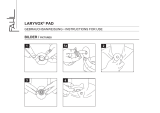 Fahl LARYVOX® PAD Mode d'emploi
Fahl LARYVOX® PAD Mode d'emploi
-
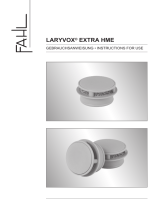 Fahl LARYVOX® MY EXTRA HME Mode d'emploi
Fahl LARYVOX® MY EXTRA HME Mode d'emploi
-
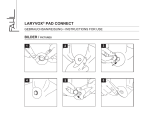 Fahl LARYVOX PAD CONNECT Mode d'emploi
Fahl LARYVOX PAD CONNECT Mode d'emploi
-
 Fahl LARYVOX® STOMALIGHT Mode d'emploi
Fahl LARYVOX® STOMALIGHT Mode d'emploi
-
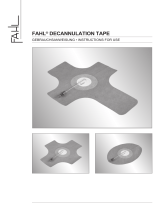 Fahl ® DECANNULATION TAPE COMFORT Mode d'emploi
Fahl ® DECANNULATION TAPE COMFORT Mode d'emploi
-
 Fahl LARYVOX® TRACHEOSPREIZER Mode d'emploi
Fahl LARYVOX® TRACHEOSPREIZER Mode d'emploi
-
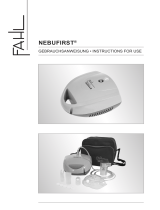 Fahl NEBUFIRST® Mode d'emploi
Fahl NEBUFIRST® Mode d'emploi
-
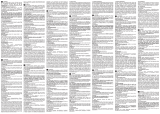 Fahl ® OPTIFLUID® LUBRICANT GEL 20 G Mode d'emploi
Fahl ® OPTIFLUID® LUBRICANT GEL 20 G Mode d'emploi
-
 Fahl LARYVOX® INSERTER UNIEK Mode d'emploi
Fahl LARYVOX® INSERTER UNIEK Mode d'emploi
-
 Fahl SENSOFOAM® PAD Mode d'emploi
Fahl SENSOFOAM® PAD Mode d'emploi



























